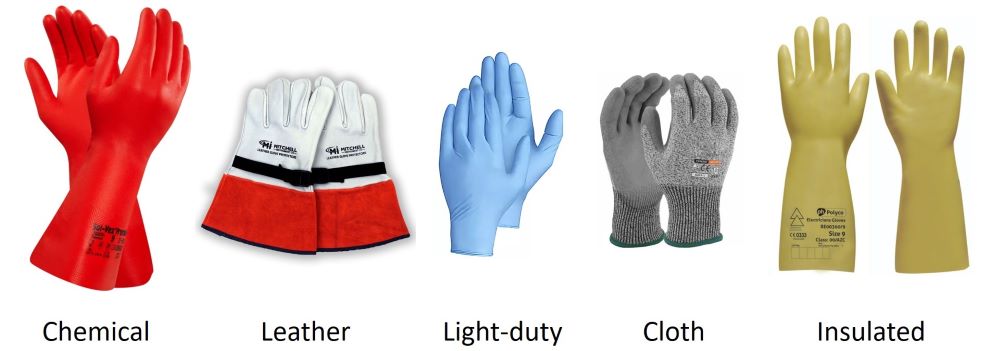Hand Protection
Any activity on a vehicle requires the use of hands, which presents many opportunities for injury. They are susceptible to injury. Wear gloves whenever necessary to protect your hands. There are many types of gloves available for different activities. You must wear the correct type of gloves for glove for the various activities you perform. In some cases, such as when working on rotating equipment, it may be better to remove your gloves so they don’t get caught in the machine and pull you into it.
Chemical and liquid-resistant gloves should always be worn when using solvents, cleaners and when working on batteries. These gloves are also slightly heat resistant and should extend to the middle of the forearm to reduce the risk of chemical burns. Always inspect gloves for holes or tears before use and replace them when worn. This type of glove is suitable for use when removing the radiator cap and mixing coolant.
Leather gloves protect hands from sharp objects and burns when welding or handling hot components. When handling hot components, leather gloves accumulate heat. When they can no longer absorb the heat, they begin to transfer it to the inner part of the glove and hand. At that point, the ability to protect against heat is reduced and you must stop working. Remove the leather gloves and allow them to cool before continuing. Avoid handling very hot metal with leather gloves as this causes the leather to harden making it less flexible during use. Use appropriate tongs to move very hot metal.
Light-duty gloves serve to protect against grease and oil. They are made of nitrile, latex or vinyl (plastic). Vinyl gloves have the lowest quality, but they are also the cheapest. Some people have allergies to these gloves. They can use gloves with powder that protects the skin. However, powdered gloves are messy because they leave marks on hands, clothes and things.
Cloth gloves are for wearing in low temperatures. They are suitable so that the cold tool does not stick to your skin, especially during the winter. Over time, cloth gloves accumulate dirt and you must wash them regularly. Check whether they are damaged and worn and replace them if necessary. These gloves are not for protection against chemicals and oils and do not use them for that.
Insulated gloves for working on high-voltage systems of hybrid and electric vehicles. Class 0 electrical insulating gloves for voltages of 1000 – 1500 V. They are tested at 5000 V so they can be sure to withstand high voltages while retaining their basic properties. Most often, they are made of non-conductive natural latex with the properties of having high dielectric strength and high resistance. They have an ergonomic shape and length to protect up to the forearm of the hand. When mechanical hand protection is also required, leather gloves are worn over this.
Barrier creams are also used to protect hands. It nourishes the skin of the hand and prevents the absorption of chemicals. It is applied before starting work. Standard creams are not an alternative and do not protect like a barrier cream. Also, the barrier cream makes it easier to clean your hands because it prevents small impurities from sticking to the skin. Do not use standard creams as a substitute for a suitable barrier cream.
Use only specialized hand cleaners to clean your hands. These products effectively clean, protect and nourish your skin. The skin on the hands is porous and easily absorbs liquid on contact. Never use solvents such as benzine or thinner to clean your hands, as they can remove the skin’s natural protective oils and enter your bloodstream.







